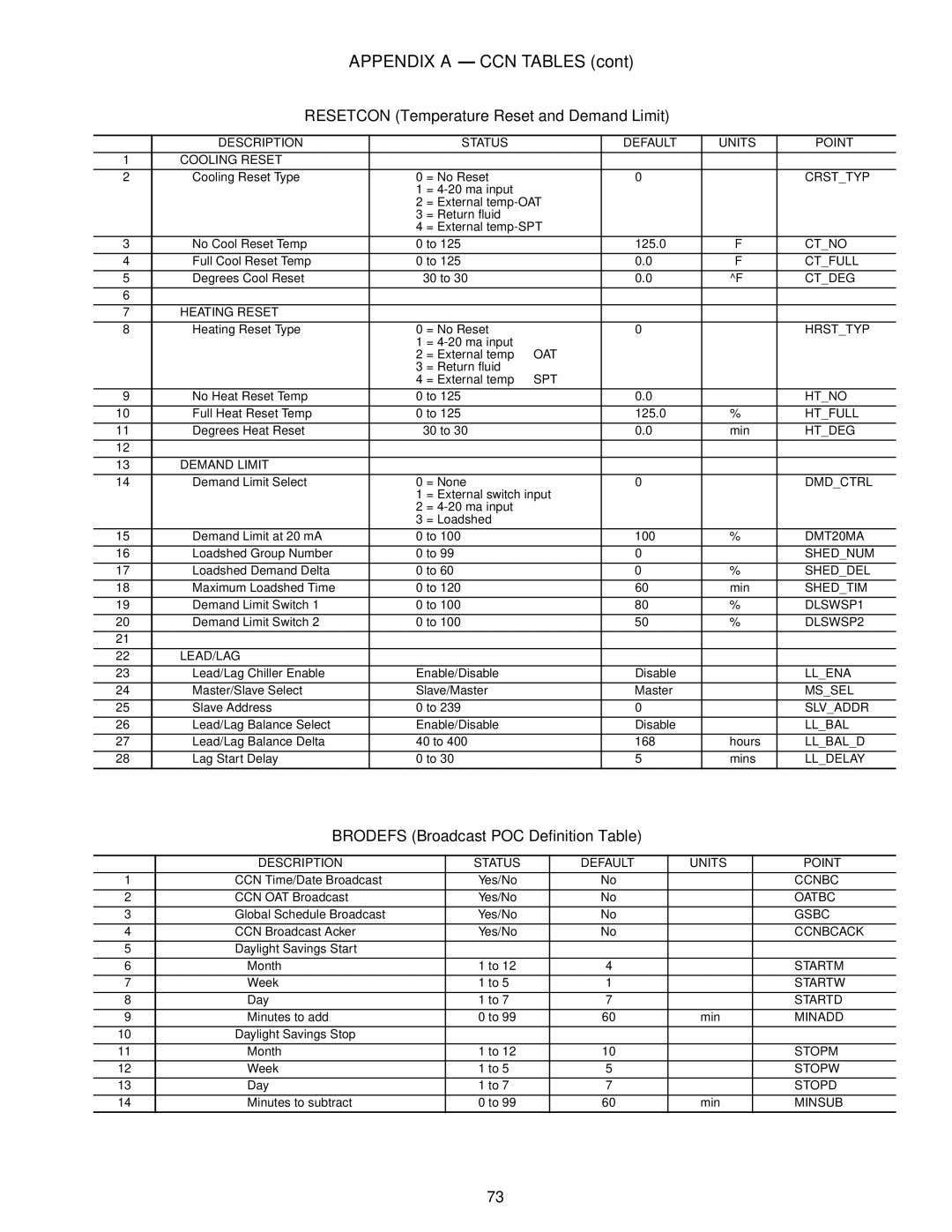Contents
Safety Considerations
General
Contents
Introduction
Unit Sizes and Modular Combinations 30GTN,R
Major System Components
Unit Sizes and Modular Combinations 30GUN,R
Unit Nominal Section a Section B 30GTN,R Tons Unit 30GTN,R
Carrier Comfort Network CCN Interface
Control Module Communication
Thermistor Designations
Output Relay
Status Switches
Page
24 V Control Schematic, Unit Sizes
24 V Control Schematic, Unit Sizes 080-110, 230B-315B
CCN LEN Data Communication Port
Main Base Board
040-110 130-210
Operating Data
Thermistor T3 and T4 Locations
Compressor Thermistor Locations T7 and T8
Manufacturer
Regular Wiring Plenum Wiring Alpha 1895 American
Belden 8205
Columbia D6451 Manhattan M13402 M64430 Quabik 6130
Compressor Protection Control System Module Sizes
Stepper Motor 12 VDC
CEPL130351
Displacement Compressors
Part Load Data Percent Displacement, Standard Units
30GUN,R
Approx
255A 60 Hz
110, 290B
360B 50 Hz
330A/B
390B 60 Hz
390B 50 Hz
B1†
A1,B1 A1†,A2,B1 A1*,B1†,B2
Unloaded compressor Two unloaders, both unloaded
190, 290A, 360A/B
170, 270A
A1*,B1*,B2
150-210
Required Hardware for Additional Unloaders
Pumpout
Head Pressure Control
FAN Arrangement FAN Relay Normal Control
Power
Scrolling Marquee Display
Service Test See Both main power
GEN.O Test
Modes
SUB-MODE Keypad Range Item Expansion Comment Entry View
Run Status Mode and Sub-Mode Directory
Strt
Vers
SUB-MODE Keypad Range Item Expansion Comment Entry Test
Service Test Mode and Sub-Mode Directory
Outs
Pressure Mode and Sub-Mode Directory
Temperature Mode and Sub-Mode Directory
Set Point Mode and Sub-Mode Directory
Reading and Changing Chilled Fluid Set Point
Inputs Mode and Sub-Mode Directory
SUB-MODE Keypad Range Item Expansion Comment Entry GEN.I
Crct
Configuration Mode and Sub-Mode Directory
Outputs Mode and Sub-Mode Directory
SUB-MODE Keypad Range Item Expansion Comment Entry GEN.O
OPT2
OPT1
CCN
EMM
Rset
240
SUB-MODE Keypad Display Item Expansion Comment Entry Rset
Example of Temperature Reset Return Fluid Configuration
Example of Configuring Dual Chiller Control Slave Chiller
Example of Configuring Dual Chiller Control Master Chiller
SUB-MODE Keypad Entry Display Item Expansion Comment Rset
Time Clock Mode and Sub-Mode Directory
Example of Compressor Lead/Lag Configuration
SUB-MODE Keypad Display Item Expansion Comment Entry OPT2
SUB-MODE Keypad Entry Item Expansion Comment Range Time
Operating Mode and Sub-Mode Directory
Setting an Occupied Time Schedule
Operating Modes
Mode no Item Expansion Description
Example of Reading and Clearing Alarms
Alarms Mode and Sub-Mode Directory
Mode Keypad SUB-MODE
Configuring Temperature Reset
Configuration
Entry Expansion
RED LED Entry Expansion Configuration
DLS2
Configuring Demand Limit
To 20 mA Demand Limiting
Troubleshooting
Page
T051
Alarm and Alert Codes
EWT
By Control Method Cause Code Alert GENERATED?
FSM
LCW
T155
T153
T170
T173
T204
T203
T205
T206
Electronic Components
Service
Oil Charge
Compressor OIL Required
Cooler Thermistor Locations
Components for Part Number Plugging
Plugs
Cooler Head Bolt Tightening Sequence Typical Tube Sheet
Condenser Coils
Dimension FAN Type
Condenser Fan Adjustment Hz Low Noise Fan Option Units
Refrigerant Feed Components Each circuit has
Printed Circuit Board Connector
Thermistors Temperature Sensors
Drop B
5K Thermistor Temperature F vs Resistance/Voltage
Drop a
5K Thermistor Temperature C vs Resistance/Voltage
Temp Voltage Resistance Drop
200,510
Switch Cutout CUT-IN
Pressure Switch Settings Psig kPa
30GTN,R Units
30GUN,R Units
System Check
PRE-START-UP
Temperature
Temperature Limits for Standard Units
Maximum Ambient Temperature 125
START-UP and Operation
Refrigerant Circuit
Field Wiring
Nominal and Minimum Cooler Fluid Flow Rates
CWP
ALM
Hgbps
Energy Management Module EMM Wiring
Compressor Expansion Board CXB Accessory Wiring
OPTIONS1 Options Configuration
Unit Configuration Settings
Description Status Default Units Point
Description Status Default Point
Alarmdef Alarm Definition Table
OPTIONS2 Options Configuration
Appendix a CCN Tables
Brodefs Broadcast POC Definition Table
Resetcon Temperature Reset and Demand Limit
Circaan Circuit a Analog Parameters
Aunit General Unit Parameters
Circadio Circuit a Discrete Parameters
Description Status Units Point Forceable
Circbdio Circuit B Discrete Parameters
Circban Circuit B Analog Parameters
Options Unit Parameters
Description Status Units Point
Strthour
Currmods
Description Status Units Point Defaults
Line Description Point
CSM/FSM Equipment Table Type 621H, Block
Description Status Point
Cooler Fluid Pressure Drop Curves 30GUN,GUR040-110
Appendix B Fluid Drop Pressure Curves
Cooler Fluid Pressure Drop Curves 30GUN,GUR130-210
Appendix B Fluid Drop Pressure Curves
Cooler Pressure Drop KEY
Appendix B Fluid Drop Pressure Curves
Cooler Fluid Pressure Drop Curves 30GUN,GUR230B-315B
Cooler Fluid Pressure Drop Curves 30GTN,GTR040-110
Cooler Fluid Pressure Drop Curves 30GTN,GTR130-210
Appendix B Fluid Drop Pressure Curves
Module B 30GTN,GTR230,245 Module B 30GTN,GTR255,290,315
Call for Free Catalog
Service Training
Remove and use for job file Preliminary Information
START-UP Checklist for Comfortlink Chiller Systems
Equipment Chiller Model no
Preliminary Equipment Check Check box if complete
UnitStart-Up
System Fluid Volume in Loop Type System
Unit Start-Up
Ccna
Description Status Units Value Ctrl
Ccnb
Baud
Slct Heating Cooling Setpoint Select
CND.P RMT.A
All Units
